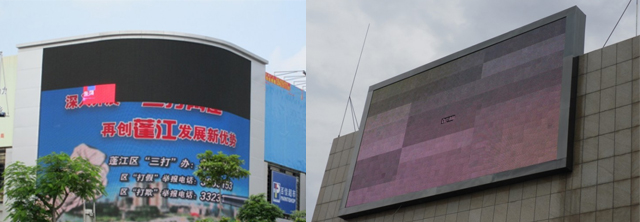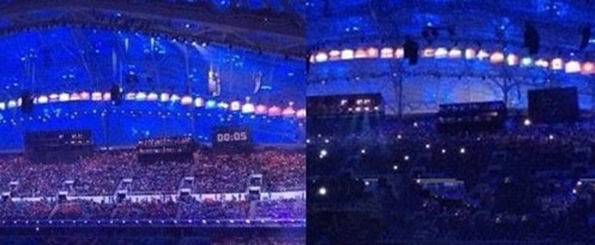
Sochi Winter Olympics "Black Screen Accident"
At the opening ceremony of the 2014 Winter Olympics in Sochi, Russia, the countdown card suddenly went black when the countdown took place. In addition, at the opening, there were also problems with the display of the Olympic rings on the big screen, resulting in only the “fourth ring†in the final five-ring model, which attracted the organizers.


2015 Beijing Film Festival “Black Screen Accidentâ€
At the 5th Beijing International Film Festival in 2015, Dapeng's new work, Pancake Mania, won the most IP hot IP award. However, when Dapeng delivered an award-winning speech, the back of the LED display was suddenly partially black, causing some materials prepared by the program team to fail to display completely. Not only did Dapeng himself half a head but originally prepared and live guests Huang Xiaoming ten years ago. The photo cannot be fully displayed, quite disappointing.

The black screen of LED display is not big, causing no hidden dangers, but it brings many distresses to end customers and renters. Especially for live events like large-scale events such as the Olympics and film festivals, the LED display has a large black screen and may even cause irreparable live broadcast accidents. As a result, end-customers, renters, and LED display companies will suffer a lot of losses, especially for rental companies and LED display companies. This may even affect the loss of important customers and affect future cooperation. So the black screen problem of LED display is a problem that needs attention. So, what are the causes of the black screen failure of the LED display? How should we solve it?

It is understood that 80% of LED display fault is the following factors: AC power distribution wiring harness, terminals, connectors, signal and low voltage DC connection harness and connector, switching power supply module, fan, plastic shell components. If these interfaces, cables, power supply, and bottom case are not selected, it will cause the entire or partial black display of the led display screen, Huaping, mosaic, and no signal.
80% of the remaining faults are due to the following causes: Solder joints on the PCBA, capacitors, terminals, and LED lights; accumulation of leaking dust due to insufficient protection of the cabinet; leaking of the hardware hardware of the leaking screw; control of the board. These reasons may cause the led display to have a deuterium light or highlight, one or more lines are not lit, lack of color, etc. If the control card or software has a problem, the image display may be abnormal.
Occasionally, during the application of the control system, the LED display screen appears black. The same phenomenon may be caused by a variety of reasons, and even the darkening of the display screen may be different for different operations or different environments. For example, it may be black at the moment of power-on, or it may turn black during loading, or it may turn black after sending.

The black screen phenomenon is caused by power problems. The main solutions are:
1. Establish quality standards, do some spare parts for display power, and reduce the failure rate of shipments.
2. Improve design parameters and improve power supply efficiency; for example: full load efficiency, reduce ripple, reduce temperature rise, and retain over 30% of power redundancy.
3, implementation of strict production management, improve the production process, to ensure product batch consistency.
4. For occasions with high requirements on the stability of the LED display, increase the power-related functions to ensure never black screen. For example, the use of on-site maintenance-free power supply, a substantial increase in the reliability of the display power supply; the use of intelligent power supply, when the screen power supply fails, the failure will be automatically reported, and other power will be compensated accordingly to ensure that the screen is not black.
In the process of using the control system, there are black screen problems. The main solutions are:
1. Make sure that all hardware, including the control system, is properly powered on. (+5V, do not connect, connect wrong)
2. Check and re-check whether the serial cable used to connect the controller is loose or missing. (If it becomes dark during loading, it may be caused by this reason, that is, it is interrupted during the communication process due to the loose communication line, so the screen is black. Do not think that the display screen is not moving, the line cannot be loosened, please Check it out, this is very important for you to solve the problem quickly.)
3. Check and confirm whether the LED display panel and the HUB distribution board connected to the main control card are tightly connected or not.
4. Please check and confirm whether the 50-core cable between the connected smart letter control card and the HUB distribution board is loose or inserted.
5. If the definition of your display interface does not match the provided HUB board, a black screen may also appear. Please check your jumpers for looseness, open circuit or short circuit. If you think that the signals such as ABCD have been matched one by one, please check whether the OE signal is connected correctly. (It is strongly recommended to use a HUB distribution board that matches the display interface definition.) If the above aspects are carefully checked, the black screen problem is solved naturally.
Oxide powder for thermal spray refers to a type of powder material that is used in thermal spray processes. Thermal spray is a coating technique where a material in powder form is heated and propelled onto a substrate, forming a coating.
Oxide powders are commonly used in thermal spray applications due to their high melting points, excellent wear resistance, and thermal insulation properties. They can be used to create protective coatings on various surfaces, such as metals, ceramics, and plastics.
Some common types of oxide powders used in thermal spray include:
1. Aluminum oxide (Al2O3): This oxide powder is widely used for its high hardness, wear resistance, and thermal insulation properties. It is commonly used for coating applications in industries such as aerospace, automotive, and electronics.
2. Zirconium oxide (ZrO2): Zirconium oxide powder is known for its high melting point and excellent thermal barrier properties. It is often used in thermal spray coatings for gas turbine engine components, where thermal insulation is critical.
3. Chromium oxide (Cr2O3): Chromium oxide powder is used for its high hardness, corrosion resistance, and wear resistance. It is commonly used in applications where high temperature and abrasive wear resistance are required.
4. Titanium oxide (TiO2): Titanium oxide powder is known for its high refractive index and excellent UV resistance. It is often used in thermal spray coatings for optical and decorative applications.
These oxide powders can be applied using various thermal spray techniques, such as flame spraying, plasma spraying, or high-velocity oxy-fuel (HVOF) spraying. The choice of oxide powder and thermal spray technique depends on the specific application requirements and desired coating properties.
Oxide Ceramics Powder,Pure Aluminum Oxide Powder,Chromium Oxide Ceramics Powder,Yttria Stabilized Zirconia Powder
Luoyang Golden Egret Geotools Co., Ltd , https://www.xtchvaf.com